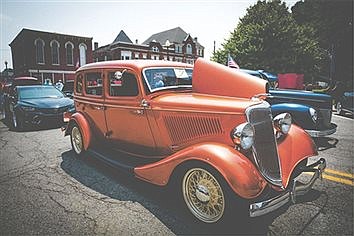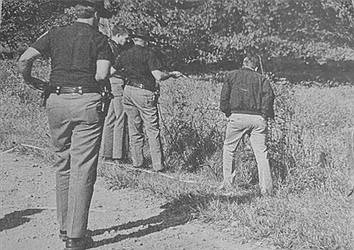Updates provided on downtown restoration
May 10, 2022 at 9:01 p.m.

Monday evening, the Downtown Facade Improvements met to discuss the upcoming requirements and events surrounding the restoration of downtown Brookville, while keeping its historic charm.
Curtis Ward, Brookville Council President, began the meeting with his eagerness to announce that they are officially moving further along in the process, as many felt the planning stage seemed to have no end. Presenting with Curtis were Nancy Main, executive director of Brookville Main Street. She helped write the grant, as well as coordinated with every step of the process to ensure progress. Jess Hansel, who works with Brookville's Special Projects. Tara Hagen, with OCRA, attended as the main administrator for the project. One of her roles is to ensure the committee stays in compliance of the grant to avoid disregard. David Kroll and Julie Zent represented the Architectural aspects to help design and plan the projects.
Eligibility requirements, Design, Next Steps, and a Q&A were covered in the meeting. Ward states a reminder that this is still a pilot program, but he and the team are working to answer all questions and concerns as the project moves forward.
Tara took the stand to explain eligibility requirements through OCRA. She started with how this project began with Brookville Main Street being eligible to write a letter of intent to the Indiana Office of Community and Rural Affairs (OCRA). The letter of intent covered a few certain areas: an overall need of the town of Brookville, show proof of community engagement and willingness to work with the town of Brookville and building/business owners, show capacity they were able to administer the grant for two years, show physical management, and fundraising capabilities.
“Five communities were selected for site visits and they did an awesome job. I have to say that you should have been here to see that presentation. It was amazing. As soon as the presentation was over, I didn't see any reason as to why they wouldn't choose Brookville," Tara says.
After visiting all five sites, Tara says that instead of one $2 million grant, OCRA gave out two, $2-million dollar grants. Brookville was awarded one and Kendallville was awarded the second. This award is a two-step process consisting of planning and construction. Right now, Brookville is still in the planning process and the end results to be expected are a revitalized downtown, a sustainable historic preservation that can be shared with other communities, a planning document that will aid in the future preservation, and a capacity to build Brookville Main Street to be a nationally recognized Main Street.
Those eligible include the Downtown Historic District, the commercial properties located in that designated Main Street section, those listed on or in that national registry of Downtown Historic District, and buildings owned by the town. Those owned by the town cannot be used for the general conduct of government. These include town halls, administrations, police departments, and jails. Residential locations that conduct business are also ineligible; however, she states that one part is still in discussion. This covers any properties that have a second and third story floors are most likely ineligible, but the team is planning to discuss these properties in depth with OCRA.
David Kroll next spoke to discuss how the Architectural aspects and design play a part. They have done business and side projects all throughout the state. He explains their other team members, such as Ann Schneider, assists in walk-throughs and deep observations of properties to determine their conditions. Mike Lawson, a construction engineer, searches and notes all construction issues and needs.
In the marked Historic district, David mentions that several buildings are listed as contributing, which means they were built during a period of significance. Yet, they still retain their appearance and character as a historic building. Non-contributing buildings include those outside the district. The period of significance ranges from the 1800s to about 1963. So even if buildings were built in this period, if they have been altered too much, have a slipcover on, then they are no longer contributing.
"We are in building selection right now. There will be a selection of up to twenty-five different buildings. Starting in early June, we will be coming down to meet with everyone and began looking through their properties for a full assessment," David explains.
The next phase, or final, is taking the photos, plans, assessments, and needs, and submitting them into design development. This phase is where designs are planned out and costs added in.
Those applying will be contacted to have their properties researched. These include maps, original photos, any information they can have from the building owner. David and Julie will be out in the field, inspecting thoroughly to determine what will suit the building best. Suggestions from the building owners are encouraged and will be considered. Each building will have an established budget based on prior updates and fixes, and the upcoming renovations.
“The roof, the bricks, doors and windows, store fronts, awnings, paintings, and structure determine eligibility," Julie states via the design process.
Requirements are necessary, but they are a standard set of ten rules to ensure the building undergoes a renovation but still maintains the historic appearance.
The meeting wrapped up with questions and answers. The team responded in kind to what they had information on at the time, such as prior apartment buildings and those in the district with a public driveway. The steps taken to fix the facade will determine how the rest of the building is altered as well. Julie and David remind the attendees that they do not enter properties without the owner's permission. Tara also mentions that when working with federal funds, there are certain regulations that they must follow. Part of this is the serious consideration taken to avoid displacement of owners and buildings. The library also states that they have an extensive collection of photos for all buildings and they would love copies if owners have some.
To end the meeting, Senator Raatz was recognized for his attendance and the influential, as well as supportive, efforts he has given since this project has begun.
Latest News
E-Editions
Events
Monday evening, the Downtown Facade Improvements met to discuss the upcoming requirements and events surrounding the restoration of downtown Brookville, while keeping its historic charm.
Curtis Ward, Brookville Council President, began the meeting with his eagerness to announce that they are officially moving further along in the process, as many felt the planning stage seemed to have no end. Presenting with Curtis were Nancy Main, executive director of Brookville Main Street. She helped write the grant, as well as coordinated with every step of the process to ensure progress. Jess Hansel, who works with Brookville's Special Projects. Tara Hagen, with OCRA, attended as the main administrator for the project. One of her roles is to ensure the committee stays in compliance of the grant to avoid disregard. David Kroll and Julie Zent represented the Architectural aspects to help design and plan the projects.
Eligibility requirements, Design, Next Steps, and a Q&A were covered in the meeting. Ward states a reminder that this is still a pilot program, but he and the team are working to answer all questions and concerns as the project moves forward.
Tara took the stand to explain eligibility requirements through OCRA. She started with how this project began with Brookville Main Street being eligible to write a letter of intent to the Indiana Office of Community and Rural Affairs (OCRA). The letter of intent covered a few certain areas: an overall need of the town of Brookville, show proof of community engagement and willingness to work with the town of Brookville and building/business owners, show capacity they were able to administer the grant for two years, show physical management, and fundraising capabilities.
“Five communities were selected for site visits and they did an awesome job. I have to say that you should have been here to see that presentation. It was amazing. As soon as the presentation was over, I didn't see any reason as to why they wouldn't choose Brookville," Tara says.
After visiting all five sites, Tara says that instead of one $2 million grant, OCRA gave out two, $2-million dollar grants. Brookville was awarded one and Kendallville was awarded the second. This award is a two-step process consisting of planning and construction. Right now, Brookville is still in the planning process and the end results to be expected are a revitalized downtown, a sustainable historic preservation that can be shared with other communities, a planning document that will aid in the future preservation, and a capacity to build Brookville Main Street to be a nationally recognized Main Street.
Those eligible include the Downtown Historic District, the commercial properties located in that designated Main Street section, those listed on or in that national registry of Downtown Historic District, and buildings owned by the town. Those owned by the town cannot be used for the general conduct of government. These include town halls, administrations, police departments, and jails. Residential locations that conduct business are also ineligible; however, she states that one part is still in discussion. This covers any properties that have a second and third story floors are most likely ineligible, but the team is planning to discuss these properties in depth with OCRA.
David Kroll next spoke to discuss how the Architectural aspects and design play a part. They have done business and side projects all throughout the state. He explains their other team members, such as Ann Schneider, assists in walk-throughs and deep observations of properties to determine their conditions. Mike Lawson, a construction engineer, searches and notes all construction issues and needs.
In the marked Historic district, David mentions that several buildings are listed as contributing, which means they were built during a period of significance. Yet, they still retain their appearance and character as a historic building. Non-contributing buildings include those outside the district. The period of significance ranges from the 1800s to about 1963. So even if buildings were built in this period, if they have been altered too much, have a slipcover on, then they are no longer contributing.
"We are in building selection right now. There will be a selection of up to twenty-five different buildings. Starting in early June, we will be coming down to meet with everyone and began looking through their properties for a full assessment," David explains.
The next phase, or final, is taking the photos, plans, assessments, and needs, and submitting them into design development. This phase is where designs are planned out and costs added in.
Those applying will be contacted to have their properties researched. These include maps, original photos, any information they can have from the building owner. David and Julie will be out in the field, inspecting thoroughly to determine what will suit the building best. Suggestions from the building owners are encouraged and will be considered. Each building will have an established budget based on prior updates and fixes, and the upcoming renovations.
“The roof, the bricks, doors and windows, store fronts, awnings, paintings, and structure determine eligibility," Julie states via the design process.
Requirements are necessary, but they are a standard set of ten rules to ensure the building undergoes a renovation but still maintains the historic appearance.
The meeting wrapped up with questions and answers. The team responded in kind to what they had information on at the time, such as prior apartment buildings and those in the district with a public driveway. The steps taken to fix the facade will determine how the rest of the building is altered as well. Julie and David remind the attendees that they do not enter properties without the owner's permission. Tara also mentions that when working with federal funds, there are certain regulations that they must follow. Part of this is the serious consideration taken to avoid displacement of owners and buildings. The library also states that they have an extensive collection of photos for all buildings and they would love copies if owners have some.
To end the meeting, Senator Raatz was recognized for his attendance and the influential, as well as supportive, efforts he has given since this project has begun.





